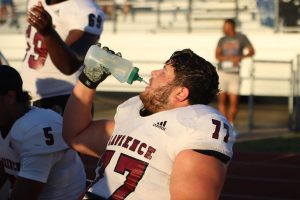The beginning of the school year and fall sports was accompanied by dangerously high temperatures, causing adaptations to sports practices and procedures. The scorching heat was unexpected, but teams found ways to continue practicing and building momentum for the new season.
Mid-August, just as fall sports started getting into swing, Kansas and the rest of the midwest endured the hottest temperatures of an already blazing summer. This posed a problem for teams like cross country, who require continuous practice to get in shape for the season. Senior cross country runner Isabel Klish said the heat made exercise exceedingly difficult.
“The hardest thing is just physically being able to keep up,” Klish said. “That heat kills you every time you’re in it, and it’s really difficult to make sure that you’re staying hydrated and not exhausting yourself.”
To ensure that they could still prepare for the season, runners moved practices to 6 a.m.
“We just would adjust our workouts, but we had stayed pretty true to what we could,” Klish said.
Despite taking precautions to avoid issues surrounding the heat, the nature of the weather still made practice brutal for the cross country team.
“It still felt like running through a sauna,” Klish said. “The humidity was at 100 percent it felt like most days, even before the sun had even risen.”
Despite the difficulty in getting to school early, Klish and other cross country athletes were relieved they were able to continue training.
“I think it was a really smart decision to avoid just canceling practice altogether, but it definitely was a big complication,” Klish said. “We’ve always kind of faced heat issues, but this has probably been the worst and I’ve been running for seven years.”
Along with cross country, other fall sports had to take precautions before continuing their activities. The football team had to ensure player safety before each practice using a wet bulb globe temperature device, or a WBGT.
“It’s a tripod that our athletic trainer puts together that she puts on the ground and measures humidity, temperature and wind speed,” Athletic Director Mike Gillman said. “That number hits a certain number. It’s either black, red, orange, yellow or white.”
Depending on the color of the reading, the team is allowed to practice a certain amount of time according to KSHAA regulations. This practice isn’t new, but this year has been especially scalding, which has made player safety an even higher priority.
“It’s the worst I’ve ever seen in 20 years of education, coaching and as an administrator,” Gillman said. “Safety was our number one concern.”

However, Gillman said the response to the weather by the school had been strong and allowed a sense of normalcy to continue.
“Everybody was kind of organized,” Gillman said. “We knew exactly what to do.”
Gillman felt that because of positive attitudes and good preparation, the athletes were able to overcome the problem presented by heat.
“We were absolutely ready for it,” Gillman said. “The WGBT took out any of the guessing. We were able to move through it.






